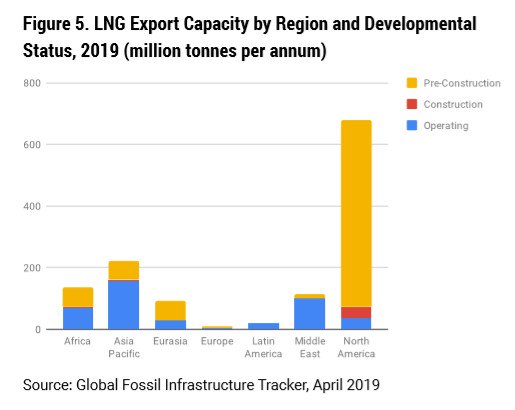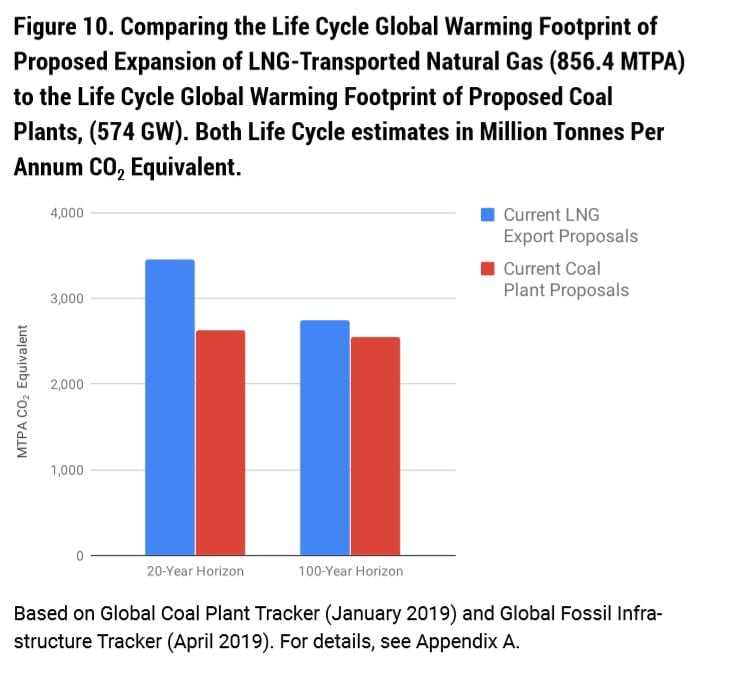The global gas market will need to slow the pace of its growth, to avoid both the risk of stranded assets and to prevent further increases to global emissions, a new report from US-based think tank Global Energy Monitor has found.
In the report, Global Energy Monitor has warned that up to US$1.3 trillion in new LNG export and import infrastructure currently under development is at significant risk of becoming stranded, as the world market for gas risks becoming oversupplied, particularly if the United States and Canada play a larger role.
More than 70% of new investment in LNG export terminals, totalling more than $910 billion, will be located in either the US or Canada, seeing the entry of two new players in a global market for gas that they have otherwise had minimal involvement.
Global Energy Monitor found it is likely that there will be significant over-investment in new gas infrastructure, as the continued emergence of lower cost renewable alternatives challenges the need for further gas supplies, creating additional risk to Australia’s already strained gas market.

If all LNG infrastructure projects in the development pipeline are completed, the global gas supply would potentially increase three-fold, at a time when the momentum is shifting towards lower emissions sources of energy, including lower cost renewables.
The findings echo a similar analysis by Bloomberg New Energy Finance that the falling costs of renewables combined with storage were able to complete new gas generation on cost.
Current commitments for further gas infrastructure investments include $38 billion in new Australian projects, the bulk of which face some degree of risk of becoming stranded assets.
Australia has emerged as one of the world’s largest exporters of natural gas, challenging Qatar for top spot after a decade of substantial investment in establishing export terminals across Queensland and Western Australia.
The report called for a moratorium on the development of further LNG export terminals, with citing both the likelihood of the export market becoming oversupplied with gas and the contribution of gas has to global greenhouse gas emissions.
Global Energy Monitor forecast that growth in natural gas use in line with infrastructure investments would make it impossible to achieve the Paris Agreement commitment to limiting warming to 1.5 degrees above pre-industrial levels.
“Given the climate mandate that natural gas be scaled back over the next decade, not to mention the risk to investors of stranded assets and financial losses from overbuilding, a sensible approach to the question of LNG terminal expansion would be a moratorium on further construction.” Global Energy Monitor said in its report.
The report from Global Energy Monitor also highlighted the fallacy behind claims by Australias energy and resources ministers, Angus Taylor and Matt Canavan, that Australia should be rewarded for exporting gas to the rest of the world.
Taylor claimed following the delayed release of an update Australia’s greenhouse gas accounts that Australia’s rising emissions should be considered in the context of Australia’s gas exports potentially being used to offset more emissions-intensive fuels overseas.
This contention is challenged by the findings of the Global Energy Monitor report, which shows gas having a similar contribution to global emissions to that of coal.
Global Energy Monitor highlighted that methane, the main component of natural gas, has been responsible for 25 per cent of the global warming observed to date.
Crucially, the report estimated that the emissions contribution of natural gas developments currently underway is equal, or greater than the expansion of coal-fired generation.

“The results of the lifecycle comparison, including fugitive methane emissions, show that current proposals for new LNG terminal capacity, if fully developed, would lock in global warming impacts that are roughly equivalent, when considered on a 100-year horizon, to those of current proposals for new coal-fired power plants.” the report said.
There has been an ongoing reconsideration of the environmental benefits of gas, following greater understanding of the life-cycle emissions of natural gas and particularly in relation to fugitive emissions during extraction and processing.
While natural gas produces fewer emissions during combustion compared to the equivalent amount of coal, when fugitive emissions are taken into account, this benefit may be reduced, if not completely eliminated.
“Because power plant combustion of natural gas produces about 40% less carbon dioxide than combustion of coal, proponents of natural gas have characterized it as a “bridge” from coal to renewables.” Global Energy Monitor said.
“However, a full life cycle comparison of both natural gas and coal requires also including the effect of leakages in natural gas production and transportation, since methane (CH4), the main component of natural gas, is a far more powerful global warming gas than carbon dioxide.”
Australia faced a grilling from other countries at a recent round of UN climate talks held in Bonn, with rising emissions from LNG production singled out as an issue requiring an explanation from Australian negotiators.
Source: RenewEconomy




